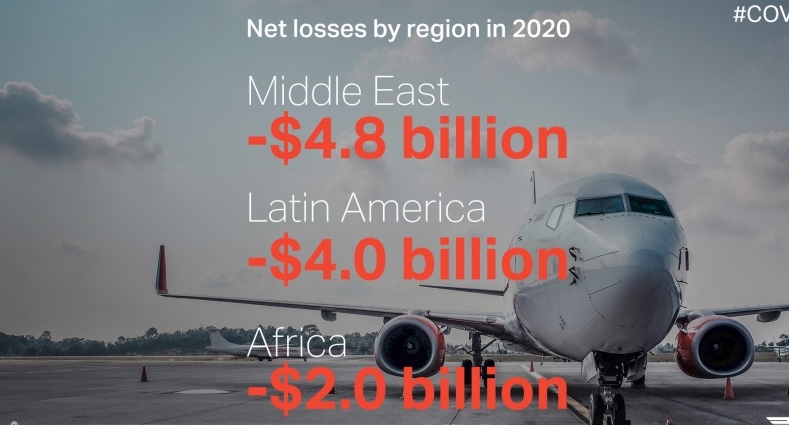IATA says industry to lose $84 bn in 2020
The International Air Transport Association (IATA) released its financial outlook for the global air transport industry showing that airlines are expected to lose $84.3 billion in 2020 for a net profit margin of -20.1 percent.

June 10, 2020: The International Air Transport Association (IATA) released its financial outlook for the global air transport industry showing that airlines are expected to lose $84.3 billion in 2020 for a net profit margin of -20.1 percent. Revenues will fall 50 percent to $419 billion from $838 billion in 2019. In 2021, losses are expected to be cut to $15.8 billion as revenues rise to $598 billion.
The course of the virus in Africa is yet to be fully seen. Nonetheless, border closures have all but stopped flights. International donors will be needed to supplement the limited means for the region’s governments to provide relief packages. The region is projected to witness a loss of -$2 billion.
“Financially, 2020 will go down as the worst year in the history of aviation. On average, every day of this year will add $230 million to industry losses. In total that’s a loss of $84.3 billion. It means that based on an estimate of 2.2 billion passengers this year - airlines will lose $37.54 per passenger. That’s why government financial relief was and remains crucial as airlines burn through cash,” said Alexandre de Juniac, IATA’s director general and CEO.
“Provided there is not a second and more damaging wave of Covid-19, the worst of the collapse in traffic is likely behind us. A key to the recovery is universal implementation of the re-start measures agreed through the International Civil Aviation Organization (ICAO) to keep passengers and crew safe. And, with the help of effective contact tracing, these measures should give governments the confidence to open borders without quarantine measures. That’s an important part of the economic recovery because about 10 percent of the world’s GDP is from tourism and much of that depends on air travel. Getting people safely flying again will be a powerful economic boost,” said de Juniac.
Cargo is the one bright spot. Compared to 2019, overall freight tonnes carried are expected to drop by 10.3 million tonnes to 51 million tonnes. However, a severe shortage in cargo capacity due to the unavailability of belly cargo on (grounded) passenger aircraft is expected to push rates up by some 30 percent for the year. Cargo revenues will reach a near-record $110.8 billion in 2020 (up from $102.4 billion in 2019). As a portion of industry revenues, cargo will contribute approximately 26 percent - up from 12 percent in 2019.
Passenger revenues are expected to fall to $241 billon (down from $612 billion in 2019). This is greater than the fall in demand, reflecting an expected 18 percent fall in passenger yields as airlines try to encourage people to fly again through price stimulation. Load factors are expected to average 62.7 percent for 2020, some 20 percentage points below the record high of 82.5 percent achieved in 2019.
Costs are not falling as fast as demand. Total expenses of $517 billion are 34.9 percent below 2019 levels but revenues will see a 50 percent drop. Non-fuel unit costs will rise sharply by 14.1 percent, as fixed costs are spread over fewer passengers. Lower utilization of aircraft and seats as a result of restrictions will also add to rising costs.
Fuel prices offer some relief. In 2019 jet fuel averaged $77/barrel whereas the forecast average for 2020 is $36.8. Fuel is expected to account for 15 percent of overall costs (compared to 23.7 percent in 2019).
All regions will post losses in 2020. The crisis has taken on a similar dimension in all parts of the world with capacity cuts lagging about 10-15 percentage points or more behind the over-50 percent fall in demand.
With open borders and rising demand in 2021, the industry is expected to cut its losses to $15.8 billion for a net profit margin of -2.6 percent. Airlines will be in recovery mode but still well below pre-crisis levels (2019) on many performance measures:
Overall revenues are expected to be $598 billion which would be a 42 percent improvement on 2020, but still 29 percent below 2019’s $838 billion.
Cargo’s enlarged footprint in the air transport industry will remain. Cargo revenues will reach a record $138 billion (a 25 percent increase on 2020). That is about 23 percent of total industry revenues, roughly double its historical share. Air cargo demand is expected to be strong as businesses restock at the start of the economic upturn, while a slow return of the passenger fleet will limit the growth of cargo capacity, and keep cargo yields steady at 2020 levels.
“Airlines will still be financially fragile in 2021. Passenger revenues will be more than one-third smaller than in 2019. And airlines are expected to lose about $5 for every passenger carried. The cut in losses will come from re-opened borders leading to increased volumes of travellers. Strong cargo operations and comparatively low fuel prices will also give the industry a boost. Competition among airlines will no doubt be even more intense. That will translate into strong incentives for travellers to take to the skies again. The challenge for 2022 will be turning reduced losses of 2021 into the profits that airlines will need to pay off their debts from this terrible crisis,” said de Juniac.


